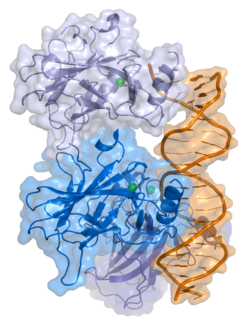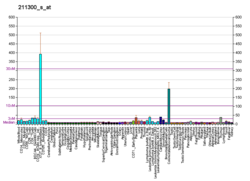p53是一系列被称为肿瘤抑制蛋白(也称为p53蛋白或p53肿瘤蛋白)的同源异构蛋白的统称。由TP53(人体)及Trp53(老鼠)基因编码。该蛋白是最早发现的肿瘤抑制基因所编码的蛋白之一。p53蛋白能调节细胞周期,促使细胞出现凋亡或细胞衰老(cell senescence)等现象,从而避免细胞癌变发生。p53蛋白能保持基因组的稳定性,避免或减少突变的发生。因此被称为基因组守护者。
| P53 |
|---|
 |
|
| 识别号 |
|---|
| 别名 | TP53;, BCC7, LFS1, P53, TRP53, tumor protein p53, BMFS5, Genes, p53 |
|---|
| 外部ID | OMIM:191170 MGI:98834 HomoloGene:460 GeneCards:TP53 |
|---|
|
| 相关疾病 |
|---|
| 基底细胞癌(BCC)、头颈部鳞状细胞癌、李-佛美尼综合征、Li-Fraumeni syndrome 1、B细胞慢性淋巴性白血病、liver carcinoma、急性骨髓性白血病、breast adenocarcinoma、gastric adenocarcinoma、肺腺癌、骨肉瘤、prostate adenocarcinoma、lung small cell carcinoma、肺鳞状上皮癌、large intestine cancer、pancreatic adenocarcinoma[1] |
|
|
| RNA表达模式 |
|---|

 |
| 查阅更多表达数据 |
| 基因本体 |
|---|
| 分子功能 | • protein N-terminus binding
• DNA结合转录因子活性
• 蛋白质自缔合
• core promoter sequence-specific DNA binding
• DNA-binding transcription factor activity, RNA polymerase II-specific
• protein phosphatase binding
• ATP结合
• 转录因子结合
• 金属离子结合
• protein phosphatase 2A binding
• 酶结合
• 锌离子结合
• chromatin binding
• 蛋白酶结合
• damaged DNA binding
• 血浆蛋白结合
• histone acetyltransferase binding
• copper ion binding
• protein kinase binding
• chaperone binding
• DNA-binding transcription activator activity, RNA polymerase II-specific
• receptor tyrosine kinase binding
• p53 binding
• 相同蛋白质结合
• protein heterodimerization activity
• 泛素蛋白连接酶结合
• RNA polymerase II transcription regulatory region sequence-specific DNA binding
• DNA结合
• RNA polymerase II cis-regulatory region sequence-specific DNA binding
• TFIID-class transcription factor complex binding
• mRNA 3'-UTR binding
• histone deacetylase binding
• 无序域特异性结合
• promoter-specific chromatin binding
• histone deacetylase regulator activity
• protein homodimerization activity
• MDM2/MDM4 family protein binding
|
|---|
| 细胞组分 | • 细胞质
• 线粒体
• 细胞核
• nuclear body
• transcription factor TFIID complex
• nuclear matrix
• replication fork
• 核仁
• 内质网
• 核质
• 线粒体基质
• PML body
• 细胞质基质
• 胞内
• 转录调节复合物
• 大分子复合体
• site of double-strand break
|
|---|
| 生物学过程 | • positive regulation of histone deacetylation
• DNA damage response, signal transduction by p53 class mediator resulting in cell cycle arrest
• rhythmic process
• replicative senescence
• negative regulation of telomerase activity
• oligodendrocyte apoptotic process
• cellular response to DNA damage stimulus
• intrinsic apoptotic signaling pathway
• positive regulation of neuron apoptotic process
• regulation of mitochondrial membrane permeability
• positive regulation of reactive oxygen species metabolic process
• cellular response to ionizing radiation
• positive regulation of thymocyte apoptotic process
• negative regulation of helicase activity
• 细胞周期
• Ras protein signal transduction
• 细胞增殖
• cellular response to hypoxia
• negative regulation of cell population proliferation
• 核苷酸切除修复
• cellular response to glucose starvation
• regulation of transcription, DNA-templated
• response to antibiotic
• transcription, DNA-templated
• ER overload response
• positive regulation of transcription, DNA-templated
• negative regulation of cell growth
• intrinsic apoptotic signaling pathway by p53 class mediator
• positive regulation of peptidyl-tyrosine phosphorylation
• viral process
• response to gamma radiation
• negative regulation of fibroblast proliferation
• positive regulation of intrinsic apoptotic signaling pathway
• 细胞分化
• determination of adult lifespan
• positive regulation of transcription from RNA polymerase II promoter in response to endoplasmic reticulum stress
• cellular response to UV
• DNA damage response, signal transduction by p53 class mediator
• negative regulation of apoptotic process
• protein tetramerization
• oxidative stress-induced premature senescence
• positive regulation of release of cytochrome c from mitochondria
• circadian behavior
• negative regulation of transcription, DNA-templated
• protein localization
• intrinsic apoptotic signaling pathway in response to DNA damage by p53 class mediator
• positive regulation of execution phase of apoptosis
• multicellular organism development
• positive regulation of protein insertion into mitochondrial membrane involved in apoptotic signaling pathway
• positive regulation of gene expression
• mitotic G1 DNA damage checkpoint signaling
• positive regulation of protein oligomerization
• positive regulation of apoptotic process
• entrainment of circadian clock by photoperiod
• response to X-ray
• positive regulation of transcription by RNA polymerase II
• base-excision repair
• DNA damage response, signal transduction by p53 class mediator resulting in transcription of p21 class mediator
• regulation of cell cycle G2/M phase transition
• proteasome-mediated ubiquitin-dependent protein catabolic process
• regulation of signal transduction by p53 class mediator
• 细胞凋亡
• transcription by RNA polymerase II
• positive regulation of protein export from nucleus
• 细胞程序性死亡
• regulation of apoptotic process
• protein deubiquitination
• phosphatidylinositol-mediated signaling
• negative regulation of transcription by RNA polymerase II
• 自噬
• mRNA transcription
• cytokine-mediated signaling pathway
• positive regulation of RNA polymerase II transcription preinitiation complex assembly
• RNA polymerase II preinitiation complex assembly
• protein homotetramerization
• protein-containing complex assembly
• cellular response to gamma radiation
• signal transduction by p53 class mediator
• cellular response to actinomycin D
• positive regulation of pri-miRNA transcription by RNA polymerase II
• positive regulation of production of miRNAs involved in gene silencing by miRNA
• in utero embryonic development
• somitogenesis
• release of cytochrome c from mitochondria
• hematopoietic progenitor cell differentiation
• T cell proliferation involved in immune response
• B cell lineage commitment
• T cell lineage commitment
• response to ischemia
• double-strand break repair
• regulation of transcription by RNA polymerase II
• protein import into nucleus
• response to oxidative stress
• transforming growth factor beta receptor signaling pathway
• 原肠胚形成
• negative regulation of neuroblast proliferation
• central nervous system development
• 心脏发育
• 昼夜节律
• negative regulation of DNA replication
• rRNA transcription
• response to UV
• response to salt stress
• embryo development ending in birth or egg hatching
• negative regulation of gene expression
• positive regulation of cardiac muscle cell apoptotic process
• cerebellum development
• negative regulation of transforming growth factor beta receptor signaling pathway
• T cell differentiation in thymus
• regulation of tissue remodeling
• multicellular organism growth
• positive regulation of mitochondrial membrane permeability
• positive regulation of transcription from RNA polymerase II promoter in response to stress
• regulation of cell population proliferation
• mitochondrial DNA repair
• regulation of DNA damage response, signal transduction by p53 class mediator
• regulation of neuron apoptotic process
• negative regulation of proteolysis
• negative regulation of mitotic cell cycle
• bone marrow development
• embryonic organ development
• protein stabilization
• chromosome organization
• neuron apoptotic process
• regulation of cell cycle
• hematopoietic stem cell differentiation
• interferon-gamma-mediated signaling pathway
• cardiac septum morphogenesis
• positive regulation of transcription from RNA polymerase II promoter in response to hypoxia
• positive regulation of programmed necrotic cell death
• intrinsic apoptotic signaling pathway in response to endoplasmic reticulum stress
• regulation of thymocyte apoptotic process
• 程序性坏死
• cellular response to UV-C
• negative regulation of mitophagy
• regulation of mitochondrial membrane permeability involved in apoptotic process
• regulation of intrinsic apoptotic signaling pathway by p53 class mediator
• negative regulation of production of miRNAs involved in gene silencing by miRNA
• negative regulation of glucose catabolic process to lactate via pyruvate
• intrinsic apoptotic signaling pathway in response to hypoxia
• regulation of fibroblast apoptotic process
• negative regulation of reactive oxygen species metabolic process
• regulation of cellular senescence
|
|---|
| Sources:Amigo / QuickGO |
|
| 直系同源 |
|---|
| 物种 | 人类 | 小鼠 |
|---|
| Entrez | | |
|---|
| Ensembl | | |
|---|
| UniProt | | |
|---|
| mRNA序列 | | |
|---|
| 蛋白序列 | | |
|---|
| 基因位置(UCSC) | Chr 17: 7.66 – 7.69 Mb | Chr 11: 69.47 – 69.48 Mb |
|---|
| PubMed查找 | [4] | [5] |
|---|
| 维基数据 |
|
p53得名于1979年,因为其的分子量于SDS凝胶电泳中测得约为53kDa。不过依据氨基酸序列进行计算后发现p53蛋白的分子量应为43.7kDa.两者所测得之分子量差别是因为该蛋白中存在大量的脯氨酸残基,减缓了其在SDS胶电泳中的迁移速度。而此迁移速度减缓的效应在跨物种的p53蛋白皆已被观察,如人类,啮齿动物,青蛙和鱼类。
目前在人体内发现的p53同源异构蛋白有15种;另外由于FOXO4可和p53结合以促进细胞衰老之故[6],因此一些和FOXO4有竞争效应的胜肽,可借由将p53屏除于细胞核之外而成为返老药(Senolytic)。[6]
p53蛋白在避免癌症发生机制上扮演重要的角色,例如,细胞凋亡 (apoptosis) 、细胞衰老(cell senescence)、基因组稳定性 (genetic stability) 、抑制血管新生 (angiogenesis)。
p53蛋白通过下列之机构达成避免癌症发生:
- 当DNA受损时,p53蛋白能激活DNA修复蛋白 (DNA repair proteins)。
- p53蛋白能抑制细胞生长,通过使细胞周期停留于G1/S的节律点上,以达成DNA损坏辨识。 (若能将细胞于此节律点上停留够久,DNA修复蛋白将有更充裕的时间修复DNA损坏部位,并继续细胞的生长周期。)
- 若细胞的DNA受损已不能修复,p53蛋白能起始细胞凋亡程序,避免拥有不正常遗传信息的细胞继续分裂生长。
激活的p53蛋白能接合于DNA,促使多个基因表达,包括基因WAF1/CIP1,其为p21蛋白之编码基因。 p21 (WAF1)接合于G1-S/CDK (CDK2) 和S/CDK复合体 (此蛋白在G1/S细胞周期节律点上有重要功能) 以抑制该复合体的活性。 当p21蛋白 (WAF1) 与CDK2形成复合体时,细胞将无法进入到细胞分裂的阶段。 而突变后的p53蛋白将可能丧失与DNA形成有效结合的能力,造成p21蛋白将无法形成,以发出停止细胞分裂的信号。 因此,受损细胞将不受控制的进行细胞分裂,最终形成肿瘤。
根据最近的研究,p53蛋白与RB1程序经由p14ARF蛋白相互调节的可能性更加提高。
p53蛋白借由许多不同的压力形式而激发其活性,其中包括但不仅仅局限于DNA损伤 (包括 UV, IR或化学物质如过氧化氢 (hydrogen peroxide)所造成的损伤),氧化压力 (oxidative stress),渗透压力 (osmotic stress),核糖核苷酸缺乏 (nucleotide depletion) 和丧失调节癌基因表达能力。这些活性激发可由两个主要的事件得出。首先,在受到压力的细胞中,p53蛋白的半衰期 (half-life) 会突然的增加,造成p53蛋白在细胞中的累积。再来则是构型变化 (conformational change) 使得p53蛋白被激发成为转录调节因子 (transcription regulator)。
- ^ 與P53相關的疾病;在維基數據上查看/編輯參考.
- ^ 2.0 2.1 2.2 GRCh38: Ensembl release 89: ENSG00000141510 - Ensembl, May 2017
- ^ 3.0 3.1 3.2 GRCm38: Ensembl release 89: ENSMUSG00000059552 - Ensembl, May 2017
- ^ Human PubMed Reference:. National Center for Biotechnology Information, U.S. National Library of Medicine.
- ^ Mouse PubMed Reference:. National Center for Biotechnology Information, U.S. National Library of Medicine.
- ^ 6.0 6.1 Baar, Marjolein P.; Brandt, Renata M.C.; Putavet, Diana A.; Klein, Julian D.D.; Derks, Kasper W.J.; Bourgeois, Benjamin R.M.; Stryeck, Sarah; Rijksen, Yvonne; van Willigenburg, Hester; Feijtel, Danny A.; van der Pluijm, Ingrid; Essers, Jeroen; van Cappellen, Wiggert A.; van IJcken, Wilfred F.; Houtsmuller, Adriaan B.; Pothof, Joris; de Bruin, Ron W.F.; Madl, Tobias; Hoeijmakers, Jan H.J.; Campisi, Judith; de Keizer, Peter L.J. Targeted Apoptosis of Senescent Cells Restores Tissue Homeostasis in Response to Chemotoxicity and Aging. Cell. March 2017, 169 (1): 132–147.e16. PMC 5556182 . PMID 28340339. doi:10.1016/j.cell.2017.02.031.






